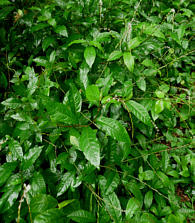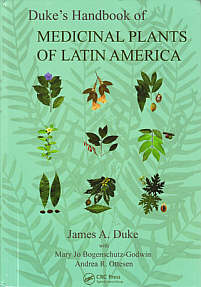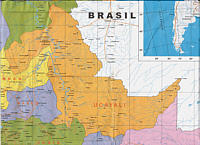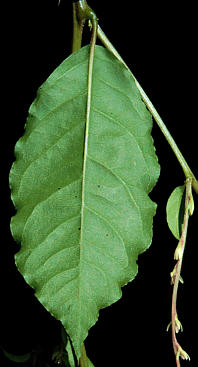|
Antiinflammatory, Analgesic, Antitumor
Anamu

Anamu
(Petiveria alliacea)
Code BOS205 -- Price: $12.50
120 Capsules x 500 mg.
Order Now
 Email
Email
 Summarized Description: Summarized Description:
Anamu is the sole species of the Petiveria genus. A shrub that
grows up to 1 meter in height, Anamu has a deep root structure, small
greenish piccate flowers, and is known for its garlic-like smell.
Ethnobotanically, the herb is used the treat cancer, leukemia, colds,
viruses, yeast infections, and UTI. Although this herbal can be found
in the U.S., in USDA Zones 9 through 11 (southern Texas and Florida),
we obtain our product from the Peruvian Amazon.
 Other common names for Anamu
include Garlic Weed -- (not to be confused with Ajo Te, or
garlic tea), Ajillo, Conga Root,
Erva de Alho, Garlic-Scented Huinea Weed, Mucura, Skunkroot, among others.
Uses & Protocols
 Anamu is normally taken either via capsules or
by infusion. Because of its strong organoleptics, we have decided to make it
only available in the 120 capsule format. Initial Dosage: One capsule, 2x a day, unless
otherwise directed by your naturopathic physician.
Warnings & Contraindications
 Do not use Anamu if you are pregnant, diabetic,
or currently using blood thinner medication -- (the reason being this herb exerts its
own mild blood thinning property.)
Shelf-Life
 Five years or more.

Medicinal Activities
 Further information for practitioners: Further information for practitioners:
World-famous botanist Dr. James Duke attributes the following activities
to this plant (p. 517-519; see hardcopy cover at right,
purchasable on Amazon),
drawn from the extant literature. (See his graduation for "level of
efficacy" on our amazon traditionals page;
followed by Duke's bibliographic abbreviations (in capital letters),
which we identify
on a separate page.)
 Duke provides a " food farmacy potential" score for this
plant of "FNFF=?."
- Abortifacient (f1; TRA; ULW; VOD; WOI; X1841991; 60P).
- Analgesic (f1; PM9:235; TRA; ULW, X1841991; X1842010; 60P)
- Anesthetic (1; TRA)
- Antiaggregant (1; RAI)
- Antidote (f; VOD)
- Antifertility (f; EGG)
- Antiherpetic (f; JTR)
- Antiinflammatory (1; PM9:235; RAI; TRA; 60P)
- Antileukemic (1; RAI)
- Antilymphomic (1; RAI)
- Antimitotic (1; MPB; X8081301)
- Antioxidant (1; RAI)
- Antiradicular (1; RAI)
- Antiseptic (f1; TRA; VOD; 60P)
- Antispasmodic (f1; TRA; VOD; WOI; ;60)
- Antitumor (1; RAI; TRA; 60P)
- Antitussive (f; DAV)
- Antiviral (1; RAI; X12138331)
- Anxiolytic (1; RAI)
- Aphrodisiac (f; IED; RAI)
- Bactericide (1; RAI; X12657295)
- Candidicide (1; RAI; 60P)
- CNS-Depressant (1; DAV)
- Contraceptive (f; DAV; RAR)
- Cyclooxygenase-Inhibitor (1; RAI; TRA)
- Cytotoxic (1; RAI)
- Depurative (f; 60P)
- Diaphoretic (1; RAI)
- Diuretic (f1; EGG; JFM; RAI; VOD; WOI)
- Emmenagogue (f1; EGG; IED, JFM; RAI, VOD; WOI)
- Expectorant (f; RAI; WOI; 60P)
- Febrifuge (f; IED, RAI X1841991)
- Fungicide (1; RAI; X12657295)
- Hallucinogenic (f; EGG)
- Hypoglycemic (1; RAI; X2100880)
- Immunostimulant (1; RAI; X10084333; 60P)
- Insecticide (f1; MPG; RAI; VOD; 60P)
- Insectifuge (f; EGG; 60P)
- Lachrymatory (1; X12657295)
- Lymphocytogenic (1; RAI)
- Mitogenic (1; AUS)
- Mutagenic (1; X1377342)
- Narcotic (f; EGG; RAR)
- Nematocide (f; 60P)
- Nervine (f; JFM)
- Pediculicide (F; JFM)
- Phagocytotic (f1; MPB; 60P)
- Protisticide (1; AUS; RAI)
- Sedative (1; RAI; X1841991)
- Sternutatory (f; DLZ)
- Sudorific (f; EGG; JFM)
- Tonic (f; EGG)
- Trypanocide (1; AUS; X9741882)
- Uterotonic (f1; MPG; 60P)
- Vermifuge (f1; JFM; RAI; VOD)
Indications
 Further information for practitioners: Further information for practitioners:
Duke provides the following indications for this plant:
- Abscesses (f; RAI)
- Acne (f; RAI)
- Amenorrhea (f; RAI)
- Anxiety (1; RAI)
- Arthrosis (1; X1842010; 60P)
- Asthenia (f; VOD)
- Asthma (f; EGG; JFM)
- Bacillus (1; MPG)
- Bacteria (1; X12657295)
- Beriberi (f; EGG)
- Bites (f; EGG)
- Boils (f; JFM; RAI)
- Bronchitis (f; DAV; EGG; SAR)
- Bugbites (f; DAV)
- Cancer (1; HAD; IED)
- Cancer, brain (1; RAI)
- Cancer, liver (1; RAI)
- Candida (1; MPG)
- Cardiopathy (f; JFM; RAI)
- Caries (f; RAI)
- Catarrh (f; JTR)
- Chagas (1; AUS)
- Childbirth (f; IED; RAI, VOD; 60P)
- Cholera (f; RAI; 60P)
- Colds (f; RAI; 60P)
- Colic (f; EGG)
- Coughs (f; MD2; RAI)
- Cramps (f1; JFM; RAI; VOD; 60P)
- Cystosis (f; JFM; MPG; RAI)
- Debility (f; VOD)
- Dermatosis (f; RAI; TRA; 60P)
- Diabetes (1; RAI; X2100880)
- Diarrhea (f; JFM)
- Dropsy (f; JTR)
- Dysmenorrhea (f; JFM)
- Dyspepsia (1; TRA)
- Earache (f; SAR)
- Edema (f1; RAI; TRA; VOD)
- Erysipelas (f; RAI)
- Escherichia (1; MPG)
- Fever (f; JFM; MD2)
- Flu (f; EGG; JFM; TRA; VOD)
- Fungus (1; MPG; RAI; X12657295)
- Gas (f; RAI)
- Gastrosis (f; RAI)
- Gonorrhea (f; EGG)
- Headache (f; JFM; MD2; TRA; VOD)
- Hepatitis-C (1; RAI)
- Hepatosis (1; RAI)
- HIV (1; AUS)
- Hives (f; RAI)
- Hoarseness (f; JFM)
- Hysteria (f; JFM; RAI; SOU)
- Induration (f; JLH)
- Infection (f12; AKT; JFM; MPG; SHT; VOD; X12657295)
- Inflammation (f1; JFM; MPG; TRA; VOD)
- Insanity (f; MPG)
- Itch (f; MD2)
- Leishmania (f; MD2)
- Listeria (1; X10084333)
- Malaria (f; RAI)
- Myalgia (f; RAI; TRA)
- Mycobacterium (1; MPG)
- Mycosis (1; MPG; RAI; X12657295)
- Nephrosis (f; RAI)
- Nervousness (f; AHL; RAI; WOI; 60P)
- Odontosis (f; RAI)
- Ostealgia (f; MPG)
- Osteoarthrosis (f; RAI)
- Pain (f1; JFM; PM9:235; TRA; ULW; X1842010; 60P)
- Paralysis (f; EGG; JFM; RAI; SOU)
- Pertussis (f; GMJ; JFM; WOI)
- Pneumonia (f; DAV; SAR)
- Pseudomonas (1; RAI)
- Pulmonosis (f; IED; ULW)
- Pyorrhea (f; MPG)
- Rabies (f; RAI; SOU)
- Respirosis (f; RAI)
- Rheumatism (f; JFM; MD2; TRA; VOD)
- Ringworm (f; JFM; MD2; RAI)
- Scabies (f; DAV; MD2)
- Shigella (1; RAI)
- Sinusitis (f; RAI; TRA)
- Snake Bite (f; IED)
- Sores (f1; MD2; VOD)
- Spasms (f; JFM)
- Staphylococcus (1; MPG; RAI)
- Stings (f; JTR; MD2)
- Thrombus (1; RAI)
- Toothache (f; EGG; TRA; VOD; 60P)
- Venereal Disease (f; EGG; JFM; JTR; RAI; 60P)
- Viruses (1; X12138331)
- Worms (f; IED; RAI)
- Wounds (f1; VOD)
- Yeast (1; RAI; 60P)
|
 To U.S. Users: To U.S. Users: This product
have not been evaluated by the U.S. Food & Drug Administration.
It is not intended to diagnose, treat, cure, or prevent any disease.
|
 Sourcing From
Sourcing From
The Peruvian
Amazon
 Although Anamu is native to
south Florida and Texas, as well as parts of Central and South America,
we source our variety of Anamu from the Peruvian Amazon.
 Recent Studies on Anamu
Recent Studies on Anamu
Sourced from PubMed
 Disclaimer: Disclaimer: The following citations provide findings on the
properties of Anamu and offer insights into prospective areas of future research.
These findings should not be inferred to provide the basis of medicinal claims,
nor should they be relied upon by the public, as such. Readers who want full access to
the PubMed database are encouraged to
register with NCBI.
 As of Jan. 2017, there were
56 citations on PubMed for Anamu. Below are list a few of the more notable:
- Ethnobotany, phytochemistry and
neuropharmacological effects of Petiveria alliacea L. (Phytolaccaceae): A review. (2016)
[CONCLUSION: Many traditional uses of P. alliacea have now been validated by modern pharmacology
research. The available data reviewed here support the emergence of P. alliacea as a potential source
for the treatment of different CNS disorders including anxiety, depression, pain, epilepsy and memory
impairments . . . ]
- Petiveria alliacea
extracts uses multiple mechanisms to inhibit growth of human and mouse tumoral cells. (2008)
[CONCLUSION: The results of this study indicate that Petiveria alliacea exerts multiple biological
activities in vitro consistent with cytotoxicity. Further studies in animal models are needed but
Petiveria alliacea appears to be a good candidate to be used as an antitumor agent.]
- A Petiveria alliacea
standardized fraction induces breast adenocarcinoma cell death by modulating glycolytic metabolism. (2014)
[CONCLUSION: A fraction of Petiveria alliacea leaves and stems induces in vitro cell death and in vivo
tumor regression in a murine breast cancer model. Our results validate in partly, the traditional use
of Petiveria alliacea in breast cancer treatment, revealing a new way of envisioning Petiveria alliacea
biological activity. The fraction effect on the glycolytic pathway enzymes contributes to explain the
antiproliferative and antitumor activities.]
- Petiveria alliacea exerts mnemonic and learning effects on rats.
(2015) [RESULTS: Consistent with our previous reports, P. alliacea improved long-term memory. It also exerted previously
unreported effects on short-term and spatial memory improvement, and increased learning in the tasks.
CONCLUSIONS: The P. alliacea extract elicited mnemonic effects and improved the learning process in both IA and MWM tests.
Our results highlight the importance of further studies in order to identify the active substances of the PaLHE and
investigate the pharmacological mechanisms that underlies the reported effects.]
-
Potential behavioral and pro-oxidant effects of Petiveria alliacea L. extract in adult rats. (2012)
[RESULTS: Consistent with previous reports, Petiveria alliacea increased locomotor activity.
It also exerted previously unreported anxiolytic and antidepressant effects in behavioral tests.
In the oxidative stress assays, the Petiveria alliacea extract decreased Trolox equivalent antioxidant capacity levels and increased methemoglobin levels, which was related to the toxic effects.
CONCLUSIONS: The Petiveria alliacea extract exerted motor stimulatory and anxiolytic effects in the OF test,
antidepressant effects in the FS test, and elicited memory improvement in ETM. Furthermore, the Petiveria
alliacea extract also exerted pro-oxidant effects in vitro and in vivo, inhibiting the antioxidant status
and increasing MetHb levels in human plasma, respectively.]

-
Immunomodulatory effects of aqueous and organic fractions from Petiveria alliacea on human dendritic cells. (2012)
[ABSTRACT Petiveria alliacea is a plant traditionally known for its anti-inflammatory and anti-tumor activities;
however, the molecular and cellular mechanisms of its immunomodulatory properties are still unknown. Dendritic cells
(DC) promote adaptive immune response by activating T lymphocytes, inducing an effector response or tolerance depending
on the DC differentiation level. Herein, we evaluated the immunomodulatory activity of aqueous and organic plant fractions
from P. alliacea using human monocyte-derived dendritic cells. The phenotype, cytokine secretion and gene expression
were estimated after treatment with the plant fractions. We found that P. alliacea aqueous fraction induced morphological
changes and co-stimulatory expression of CD86, indicating partial DC maturation. In addition, pro-inflammatory cytokines
such as IL-1β, IL-6, IL-8, IL-10, IL-12p70, and TNF-α were secreted. The fraction also increased NF-κB gene expression
while down-regulating TGFβ gene expression. These results suggest that the aqueous fraction can induce partial
DC activation, a situation that can be relevant in tolerance induction. It is important to state that the organic fraction
by itself does not show any immunomodulatory activity. This study provides evidence for possible immunomodulatory activity
of P. alliacea extracts which has been used in traditional medicine in Colombia.]
-
Cytokine profile and natural killer cell activity in Listeria monocytogenes infected mice treated orally with Petiveria alliacea extract. (2000)
[ABSTRACT: . . . Based on these findings we suggest that P. alliacea up-regulates anti-bacterial immune response
by enhancing both Th1 function and the activity of NK cells.]
-
Petiveria alliacea L. extract protects mice against Listeria monocytogenes infection--effects on bone marrow progenitor cells. (1999)
[ABSTRACT: In this study we have investigated the effects of Petiveria alliacea on the hematopoietic response of mice
infected with Listeria monocytogenes. Our results demonstrate a protective effect of the crude extract of P. alliacea since the
survival of the treated/infected was higher than that in the infected group. Moreover, the number of granulocyte/macrophage
colonies (CFU-GM) and the serum colony stimulating activity levels were increased in the treated/infected mice in relation to
the infected group. These results suggest an immunomodulation of Petiveria alliacea extract on hematopoiesis, which may be
responsible, at least in part, for the increased resistance of mice to Listeria monocytogenes infection.]

 Extensive information about
Anamu is covered on the Raintree Forest website.
Even better, you can purchase Leslie Taylor's excellent reference book,
The Healing Power
of Rainforest Herbs: A Guide to Understanding and Using Herbal Medicinals at Amazon.
 See basic
description in Wikipedia.
|


 Recent Studies on Anamu
Recent Studies on Anamu


 Recent Studies on Anamu
Recent Studies on Anamu